Jewish author inspired by Abe Lincoln
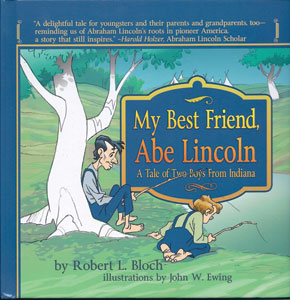 In 1820, when young Sam Harding met a tall boy named Abe, a strong friendship grew from their shared love of learning and the outdoors. At the time, Harding didn’t expect that his friend would one day grow into the man that would be considered the greatest president of all time.
In 1820, when young Sam Harding met a tall boy named Abe, a strong friendship grew from their shared love of learning and the outdoors. At the time, Harding didn’t expect that his friend would one day grow into the man that would be considered the greatest president of all time.
This is the premise of Robert Bloch’s new fictional picture book, “My Best Friend, Abe Lincoln: A Tale of Two Boys From Indiana.” The tale covers an early portion of Abraham Lincoln’s life, and imagines a character-building friendship between the future commander-in-chief and a humble farm boy.
Though Bloch created the story, he says he was drawn to the idea from real life events. Lincoln did live in southwestern Indiana at this time, the location of the story, and as in the story did attend a “blab school,” where a dozen children age 6 to 12 would blab out loud and repeat their lesson over and over again.
“I wanted children to become familiar with Lincoln, and this seemed like a great way to do it,” Bloch said. “I had never thought about writing a book before. But I have always been interested in history, and Lincoln’s life has always been fascinating.”
Bloch created several adventures for Lincoln and Harding to share. Through these adventures and the lively illustrations that accompany them, Bloch hoped to draw kids to this influential figure.
“What is inspiring is that Lincoln was such a great role model,” Bloch said. “Kids at an early age can absolutely learn a lot from his example.”
In addition to his passion for history, Bloch was also inspired by a family connection with Lincoln. Bloch’s great-great grandfather was a distinguished abolitionist who knew Lincoln and was part of a group that brought him to Leavenworth, Kan., where he delivered his first presidential campaign speech.
In addition to children, Bloch believes everyone can learn something from the 16th president.
“His sense of humor was also very noteworthy,” Bloch said. “He always had a sense of humor about everything. Even in the face of adversary, he could make a joke and keep a positive attitude. That is something we all could stand to do a little more.
“He was a great storyteller,” Bloch continued. “He used stories to keep things in perspective and to reach people.”
As the current political landscape heats up, and a new Republican candidate will try and follow in Lincoln’s footsteps, Bloch believes they too could learn from history.
“He always learned from his mistakes, and didn’t mind going through trial and error,” Bloch said. “And he wasn’t afraid to ask the advice of people who disagreed with him.
“I think you can draw comparisons with today,” Bloch said. “Lincoln is like President Obama in that they both started off poor and rose up to have the most important job in the world. And they both made history to do it.”
Bloch’s book is being sold in several local locations around the metro, while supplies last. The book can be found in the Wornall House as well as the Nelson Atkins Museum. Bloch said the easiest way to purchase the book is through Amazon. For more information on the book, visit www.mybestfriendabelincoln.com.
Illustrations for the book were crafted by former Walt Disney Studios animation artist John Ewing. Ewing has worked on many Disney films including Winnie the Pooh and Jungle Book. Resembling an animated movie, Bloch said the pictures just leap off the page. His first reaction to them exceeded his expectations.
“When I first saw it I thought it was perfect,” Bloch said. “I thought the illustrations were very warm and intimate, with an old fashion feel that really fit with the subject matter. They (the illustrations) were impressive. I am very proud of the book.”
Bloch attended both Menlo College in Menlo Park, Calif., and the University of Missouri–Kansas City. He soon plans to join The Temple, Congregation B’nai Jehudah. He has worked with the H&R Block Foundation since 1989, focusing on arts and culture grants and investments. He has enjoyed being able to combine his love of art with his love of history.
“So little is known of Lincoln’s life between 1820 and 1823 of Lincoln’s life,” Bloch said. “It has been fun using the things we do know, (his thirst for knowledge, his ability to stand up and talk in front of people, his family relationships,) to create a fun new story for children.”



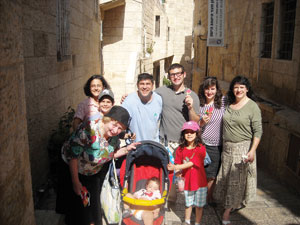 HEARTWARMING EXPERIENCE — Joyce Bratman recently had the opportunity to travel to Israel for the very first time and was able to visit her grandson, Michael Davidson, who is studying at Or Sameach Yeshiva there. She said the trip was made even more special by the chance meeting she had with friends from here. While her family was on its way to visit the Kotel (Western Wall), they literally bumped into the Rabbi Jonathan Rudnick family, who had just visited the Kotel. Bratman calls it “a wonderful, joyful spontaneous meeting, from Kansas to Jerusalem, walking in the Jewish quarter of the Holy Land of Jerusalem, Israel.”
HEARTWARMING EXPERIENCE — Joyce Bratman recently had the opportunity to travel to Israel for the very first time and was able to visit her grandson, Michael Davidson, who is studying at Or Sameach Yeshiva there. She said the trip was made even more special by the chance meeting she had with friends from here. While her family was on its way to visit the Kotel (Western Wall), they literally bumped into the Rabbi Jonathan Rudnick family, who had just visited the Kotel. Bratman calls it “a wonderful, joyful spontaneous meeting, from Kansas to Jerusalem, walking in the Jewish quarter of the Holy Land of Jerusalem, Israel.”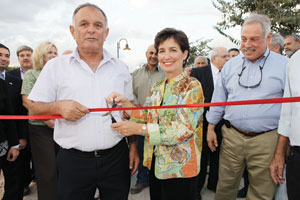 Leawood has had a park dedicated to the Gezer Region in Israel since 2009. Now Gezer has returned the favor.
Leawood has had a park dedicated to the Gezer Region in Israel since 2009. Now Gezer has returned the favor.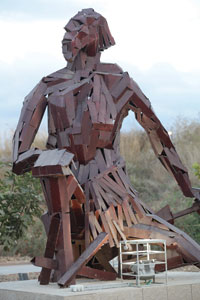 Cohen explained the square in Gezer features a sculpture of Shimon Hatarsi, the last son of the Hashmonaim, a pergola and several typical Israeli trees. He described the Leawood trail as a walking trail that will serve the citizens of Gezer who enjoy walking in the neighborhood.
Cohen explained the square in Gezer features a sculpture of Shimon Hatarsi, the last son of the Hashmonaim, a pergola and several typical Israeli trees. He described the Leawood trail as a walking trail that will serve the citizens of Gezer who enjoy walking in the neighborhood.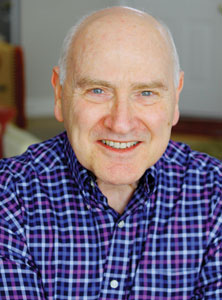 Jack Katz, Ph.D. entered the field of audiology with a goal to help people. Decades later he remains focused on that goal as a leader in the field.
Jack Katz, Ph.D. entered the field of audiology with a goal to help people. Decades later he remains focused on that goal as a leader in the field. Max Cardozo is a child of the Holocaust and lived in Nazi-occupied Holland. He published a book about his experiences, “A Child Underground” in both English and Dutch, in 2006. Six couples assisted him during that time and have been recognized as Righteous Among the Nations by Yad Vashem in Jerusalem during the last couple of years. Those people will be recognized again in a ceremony in the Netherlands Nov. 15.
Max Cardozo is a child of the Holocaust and lived in Nazi-occupied Holland. He published a book about his experiences, “A Child Underground” in both English and Dutch, in 2006. Six couples assisted him during that time and have been recognized as Righteous Among the Nations by Yad Vashem in Jerusalem during the last couple of years. Those people will be recognized again in a ceremony in the Netherlands Nov. 15. Evan Luskin sits at his desk at the Kansas City Lyric Opera, chatting on the phone about the budget. After hanging up, he says it’s “for the last time.” After 26 years, Luskin will leave the opera in June.
Evan Luskin sits at his desk at the Kansas City Lyric Opera, chatting on the phone about the budget. After hanging up, he says it’s “for the last time.” After 26 years, Luskin will leave the opera in June. FIRE ALARM FINALE — MCHE executive director Jean Zeldin tells me that the “creative ending” to the Marvin Hamlisch concert on Nov. 3 was the result of steam from the Kauffman Center’s new heating system triggering the smoke alarm. Fortunately, Maestro Hamlisch was only four bars from finishing his performance and guests returned to the dessert reception in good spirits after a 5-minute evacuation. “Nothing could spoil what was an incredibly special evening,” said Zeldin. “Our main regret was that Hamlisch wasn’t able to revel in the enthusiastic standing ovation he certainly would have received. We appreciate everyone’s cooperation and understanding.”
FIRE ALARM FINALE — MCHE executive director Jean Zeldin tells me that the “creative ending” to the Marvin Hamlisch concert on Nov. 3 was the result of steam from the Kauffman Center’s new heating system triggering the smoke alarm. Fortunately, Maestro Hamlisch was only four bars from finishing his performance and guests returned to the dessert reception in good spirits after a 5-minute evacuation. “Nothing could spoil what was an incredibly special evening,” said Zeldin. “Our main regret was that Hamlisch wasn’t able to revel in the enthusiastic standing ovation he certainly would have received. We appreciate everyone’s cooperation and understanding.” 
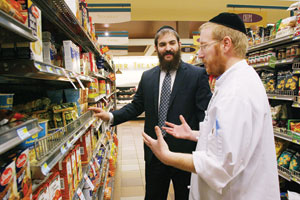 What a difference a couple of years can make. A little more than two years ago, the Vaad HaKashruth of Kansas City was a very small, staff-driven organization. Today, it is led by a board of directors — with support from every religious movement represented in the community — and is striving to become an integral part of the community.
What a difference a couple of years can make. A little more than two years ago, the Vaad HaKashruth of Kansas City was a very small, staff-driven organization. Today, it is led by a board of directors — with support from every religious movement represented in the community — and is striving to become an integral part of the community. These days, Idina Menzel is “defying gravity,” bringing her powerful voice to Helzberg Hall of the Kaufmann Center for the Performing Arts on Saturday evening Nov. 12. Perhaps best known for playing the role of the green witch Elphaba in the long-running hit Broadway musical “Wicked” (written by Jewish composer Stephen Schwartz), Menzel will appear with members of the Kansas City Symphony for a 90-minute, no intermission performance.
These days, Idina Menzel is “defying gravity,” bringing her powerful voice to Helzberg Hall of the Kaufmann Center for the Performing Arts on Saturday evening Nov. 12. Perhaps best known for playing the role of the green witch Elphaba in the long-running hit Broadway musical “Wicked” (written by Jewish composer Stephen Schwartz), Menzel will appear with members of the Kansas City Symphony for a 90-minute, no intermission performance.